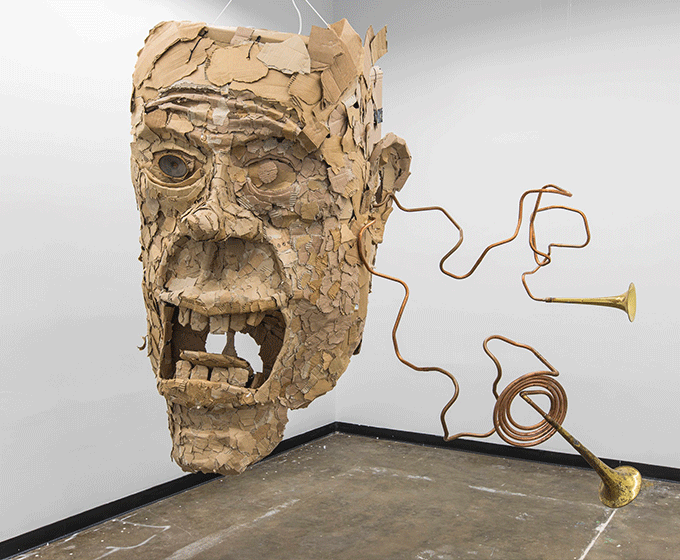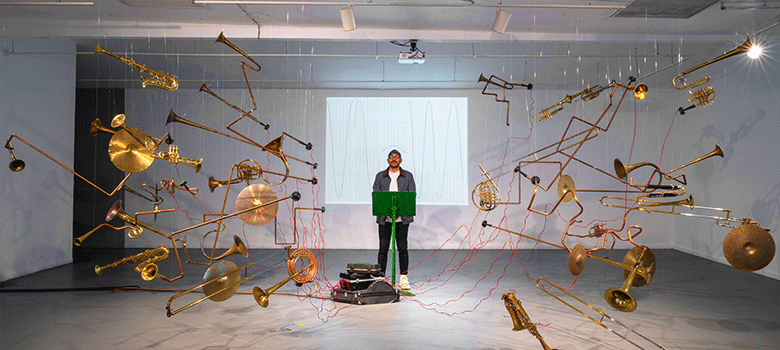
Foreign Body is an 8-foot sculpture made from cardboard, brass instruments, plants and robotics.
JULY 18, 2023 — UTSA music lecturer Steven Parker has always been interested in the connection between music education and football. His inventive work draws from the historical connections between the marching band and the military.
“Marching bands are the original sonic weapons,” he said. “Historically, they were used to maintain soldier morale, direct troops on the battlefield, and terrify enemies. Today, we can see vestiges of this on football fields when they are used to whip up crowds, intimidate opponents, and punctuate big hits.”
“But the marching band is also an expressive tool,” Parker continued, “and I am interested in highlighting this potential by combining this ensemble with the practice of Deep Listening, a practice of sonic meditation developed by the late composer Pauline Oliveros.”

Sonic Meditation for Solo Performance is an interactive installation that uses hanging brass instruments including French horns, trombones and cymbals as a tool for meditation.
Sonic meditations are written or spoken instructions that explore Deep Listening, which Oliveros described as, “a way of listening in every possible way to everything possible to hear, no matter what you are doing. Such intense listening includes the sounds of daily life, of nature, of one's own thoughts as well as musical sounds.”
Parker interweaves this concept into FIGHT SONG. This sonic art project takes on two forms. An interactive installation called Sonic Meditation for Solo Performer uses hanging brass instruments including French horns, trombones and cymbals as a tool for meditation while a video series of marching band performances in public places called Marching Band Meditations includes a halftime-style performance by the UTSA Spirit of San Antonio marching band.
On display at the nonprofit arts space the Art League Houston earlier this year, FIGHT SONG examines themes of healing, injury and labor in football. Parker, an associate professor of instruction in the College of Liberal and Fine Arts’ School of Music, was recently awarded a $30,000 Pollock-Krasner Foundation Grant for his work.
Funding from the grant supports his time away from the classroom as he continues creating new pieces for FIGHT SONG and will help cover the cost for materials used such as salvaged instruments.
Along with the Pollock-Krasner, this project is supported by the Dallas Museum of Art Dozier Award and the McKnight Foundation Visiting Composer Fellowship, where Parker became a fellow this month.
Unique to FIGHT SONG’s installation is the inclusion of an EEG headset. Viewers are turned into performers when asked to read a series of sonic mediation prompts while wearing the headset that translates their brain waves into sound. That sound is then played by the hanging brass instruments.
“I’ve worked on several pieces with Ron Ellis, director of bands at UTSA, and members of the Spirit of San Antonio band for this project and now I will be spending the next couple of years working on new pieces with marching bands from Minnesota and Ohio,” Parker said. “Both are places steeped with the culture of football much like in Texas.”
Another project supported by the Pollock-Krasner grant is Parker’s THE GOLEM, an exhibit that uses an ancient Hebrew legend to examine the future of artificial intelligence.
“The Golem is a myth of a rabbi who creates a powerful creature to defend a group of persecuted people” Parker said. “He creates it out of clay, but ultimately grows too powerful and destroys its creator. The myth is a metaphor or symbol for human hubris, and has been adapted into other stories such as the Frankenstein monster.”
Created in dialogue with an AI chatbot, the project will feature life-sized kinetic sculptures built from cardboard, brass instruments, plants and robotics, including an 8-foot interactive head, that can be animated by visitors in an 80-foot tall decommissioned silo that is home to the Site Gallery in Houston. THE GOLEM is slated for exhibition in November.
As a trombonist, composer, visual artist and curator, Parker has performed and exhibited at numerous places, including the American Academy in Rome, Italy; Crystal Bridges Museum of American Art in Arkansas; Gwangju Media Art Festival in Korea; the Guggenheim Museum in New York; the Los Angeles Philharmonic inSIGHT and locally at the McNay Art Museum.
He’s been awarded the Rome Prize, the Tito’s Visual Art Prize, a Fulbright Fellowship and grants from the National Endowment for the Arts.
From performing Luciano Berio’s “Sequenza V” at pop-up concerts to working with salvaged musical instruments and marching bands, Parker is happy to share his work with others and often encourages participation.
"I enjoy seeing how my work can facilitate performative exchanges between viewers, sculptural objects, and sound,” he said. “When the public is meaningfully involved in a piece, the performance is infused with a palpable electricity: the viewers contribute a layer of unpredictability and chance, the physical space of the performance shifts, and participants discover new expressive skills they did not know they had.”
UTSA Today is produced by University Communications and Marketing, the official news source of The University of Texas at San Antonio. Send your feedback to news@utsa.edu. Keep up-to-date on UTSA news by visiting UTSA Today. Connect with UTSA online at Facebook, Twitter, Youtube and Instagram.
Move In To COLFA is strongly recommended for new students in COLFA. It gives you the chance to learn about the Student Success Center, campus resources and meet new friends!
Academic Classroom: Lecture Hall (MH 2.01.10,) McKinney Humanities BldgWe invite you to join us for Birds Up! Downtown, an exciting welcome back event designed to connect students with the different departments at the Downtown Campus. Students will have the opportunity to learn about some of the departments on campus, gain access to different resources, and collect some giveaways!
Bill Miller PlazaJoin us for an intimate evening of cocktails, conversation, and culinary inspiration with Pati Jinich, Emmy-nominated chef and James Beard Award-winning author. Enjoy light bites and signature drinks in the warm, modern setting of Mezquite as Pati connects with guests over her passion for Mexican cuisine and storytelling.
Mezquite Restaurant in Pullman Market, 221 Newell Ave., San Antonio 78215From inspired courses to thoughtful pairings and a rich sense of community, the Ven a Comer Signature Dinner is a night of shared meals, shared stories, and unforgettable flavor.
Stable Hall (Pear Brewery), 307 Pearl Pkwy, San Antonio 78215Come and celebrate this year's homecoming at the Downtown Campus with food, games, giveaways, music, and more. We look forward to seeing your Roadrunner Spirit!
Bill Miller PlazaThe University of Texas at San Antonio is dedicated to the advancement of knowledge through research and discovery, teaching and learning, community engagement and public service. As an institution of access and excellence, UTSA embraces multicultural traditions and serves as a center for intellectual and creative resources as well as a catalyst for socioeconomic development and the commercialization of intellectual property - for Texas, the nation and the world.
To be a premier public research university, providing access to educational excellence and preparing citizen leaders for the global environment.
We encourage an environment of dialogue and discovery, where integrity, excellence, respect, collaboration and innovation are fostered.